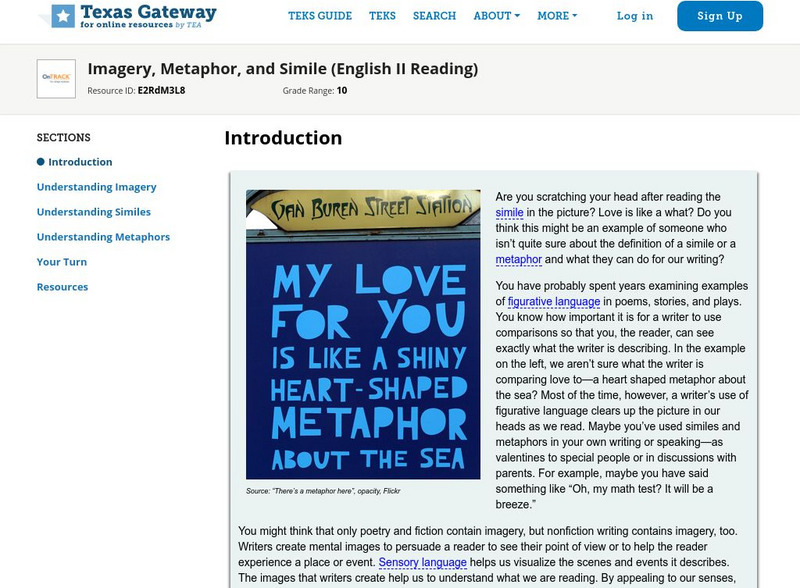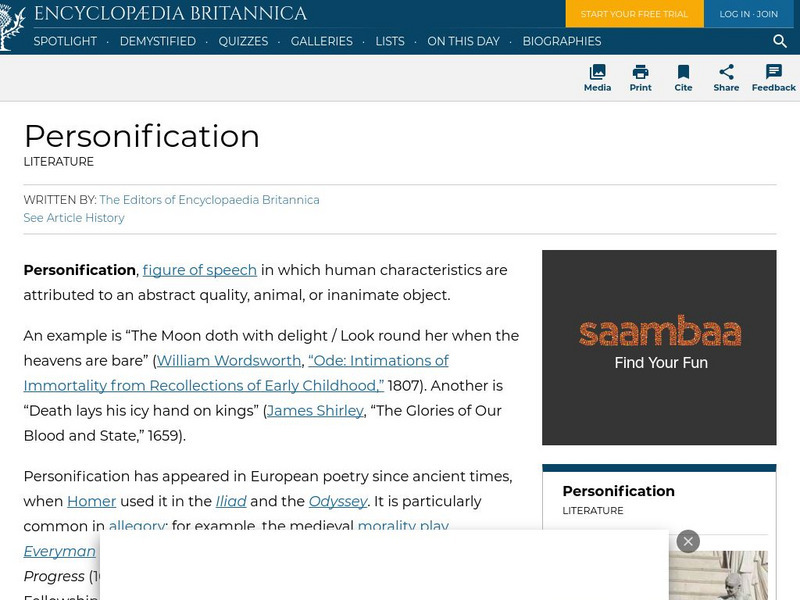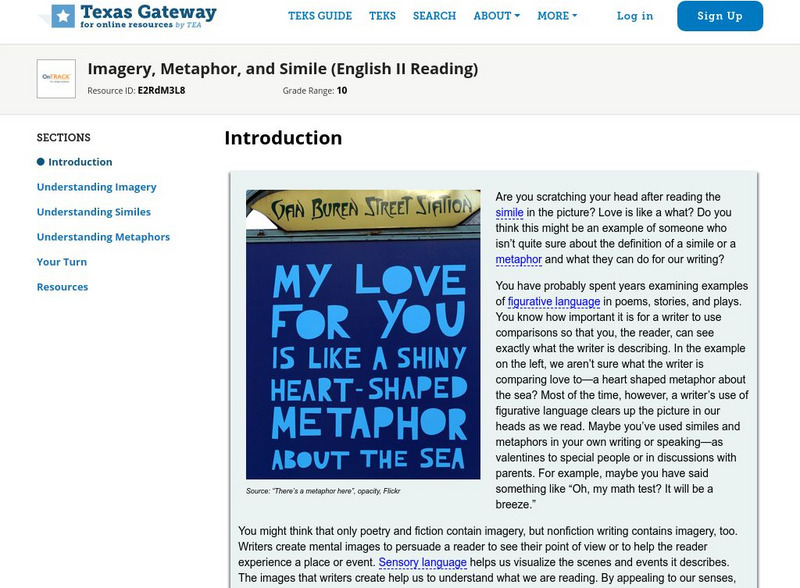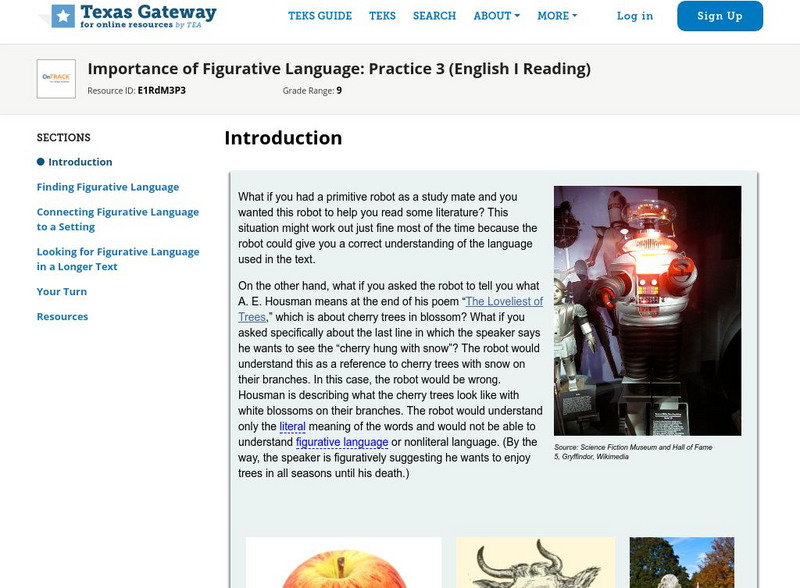University of Victoria (Canada)
The U Vic Writer's Guide: Literary Term: Allegory
This site provides an excellent description of allegory. Content includes a focus on two of the main types of allegories, as well as an example.
Virtual Salt
Handbook of Rhetorical Devices: Analogy
Defines analogy. Also explains the reasoning behind the multiple levels of comparisons within an analogy. Includes examples and quotes from famous authors.
Quia
Quia: Concentration: Literary Devices
This game asks students to match literary devices (similes, metaphors, personification, slang/dialect and allusions) with their examples while remembering where they are located behind covered squares. Java is required.
TES Global
Blendspace: Rl 5.4 Figurative Language
This twelve-part learning module provides assorted references for figurative language terms. This blendspace provides reproducible charts, flash cards, a game, video tutorial lessons, and rap songs. L.9-10.5 Fig Lang/nuances
ClassFlow
Class Flow: Poetry Figurative Language
[Free Registration/Login Required] This flipchart discusses various forms of poetry and gives examples of each. Figurative language is explored as a way of determining the meaning of a piece of literature.
Sophia Learning
Sophia: Grammar Basics: Metaphors
Learn about similes and metaphors through this multimedia presentation. First view a slide show describing different types of metaphors as well as a simile. Then watch a video [3:13] showing similes and metaphors used in popular songs. A...
Sophia Learning
Sophia: Appropriate Language
A series of three PowerPoints and two videos defining pretentious language, jargon, and cliche and explaining how writers can avoid using them. W.11-12.2d Lang/Fig/Voc
Houghton Mifflin Harcourt
Holt, Rinehart and Winston: Elements of Literature: Identifying Figures of Speech [Pdf]
A graphic organizer which allows students to document and list the figures of speech they identify in a given piece of literature. These include simile, metaphor, personification, and symbol, and require examples from the text.
E Reading Worksheets
E Reading Worksheets: Figurative Language: Shakespeare
This learning module provides remediation and extra practice with identifying figurative language techniques found in excerpts written by William Shakespeare. A worksheet is available to help reinforce the concept of figurative language...
E Reading Worksheets
E Reading Worksheets: Figurative Language Worksheets
This learning module provides remediation and extra practice with identifying different types of figurative language. Reinforcement is provided through the worksheets, quizzes, video game links, and online sites for the following types...
E Reading Worksheets
E Reading Worksheets: Figurative Language Activities
Numerous activities, games, quizzes, lessons, and PowerPoint presentations are provided for the topic of "figurative language" in writing. Students will have numerous exposures to examples. Students will also be able to practice...
The English Teacher
The English Teacher: Writing Analogies
Analogies are useful when communicating ideas that a reader wouldn't otherwise understand. This tutorial explains how to use analogy in writing.
Texas Education Agency
Texas Gateway: Simile and Metaphor
Explain the effect of similes and extended metaphors in literary text.
Texas Education Agency
Texas Gateway: Context Clues and Analogies (English Ii Reading)
[Accessible by TX Educators. Free Registration/Login Required] Learn to find the meaning of words through analogy and other word relationships. L.9-10.5 Fig Lang/nuances
Texas Education Agency
Texas Gateway: Imagery, Metaphor, and Simile (English Ii Reading)
Evaluate the role of imagery, metaphor, and simile in literary nonfiction such as speeches and essays.
Lumen Learning
Lumen: Boundless Communications: Deploying Style Effectively
This lesson plan focuses on rhetorical devices and how to use them effectively in public speaking. These include alliteration, antithesis, hyperbole, onomatopoeia, personification, repetition and parallelism, and simile and metaphor.
Texas Education Agency
Texas Gateway: Context Clues and Analogies (English Ii Reading)
[Accessible by TX Educators. Free Registration/Login Required] This lesson focuses on using a combination of reference materials and analyzing context clues and analogies to improve your knowledge of new words.
Encyclopedia Britannica
Encyclopedia Britannica: Literature: Personification
Explains what personification is and gives examples. Includes links to related articles on symbolism, elements of rhetoric, fables, figure of speech, and allegory.
San Jose State University
San Jose State University: Choosing Precise Words [Pdf]
This handout shows the difference between using precise words and more general words. W.9-10.2d lang/voc, W.11-12.2d Lang/Fig/Voc
Other
Study.com: Using Precise Language & Vocabulary in Informative Texts
This lesson focuses on using precise language in informative texts. It defines precise text and discusses how to use precise language. W.9-10.2d lang/voc, W.11-12.2d Lang/Fig/Voc
Texas Education Agency
Texas Gateway: Literary Text: Close Reading of Poetry: Practice 3
This lesson will help you comprehend the poet's meaning by giving you practice in finding imagery, metaphors, symbolism, and allusions.
Texas Education Agency
Texas Gateway: Literary Text: Imagery, Metaphor, and Simile
Writers use sensory imagery ("smelled the salty air"), similes ("like a strong man playing tug-of-war"), and metaphors ("the waves roaring in my ears") to capture the reader's imagination. In this lesson, you will learn how to identify...
Quia
Quia: Figurative Language Quiz
This 30-question quiz asks students to answer questions about figurative language by selecting the correct answer. Feedback is provided after the quiz is submitted. Java is required.
Texas Education Agency
Texas Gateway: Importance of Figurative Language: Practice 3 (English I Reading)
[Accessible by TX Educators. Free Registration/Login Required] In this lesson, you will sharpen your skill in reading figurative language and in connecting it with the historical and cultural settings in the text.



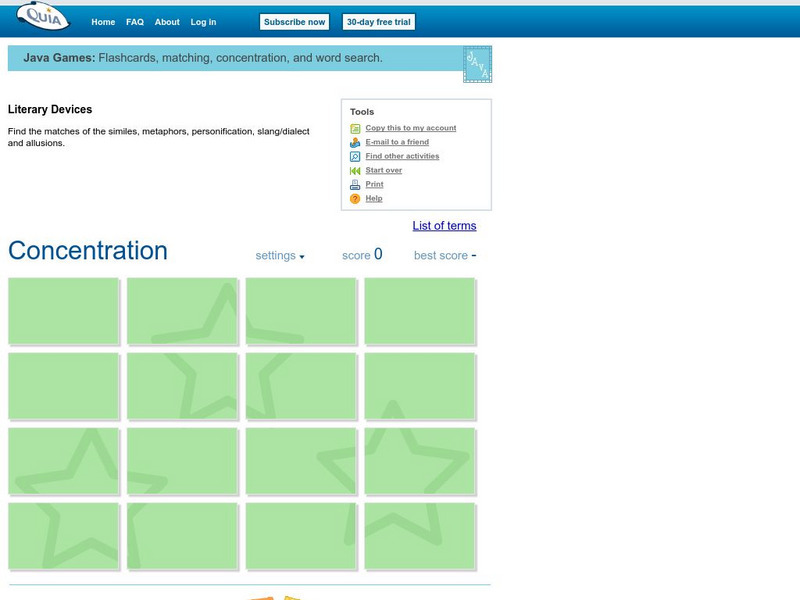
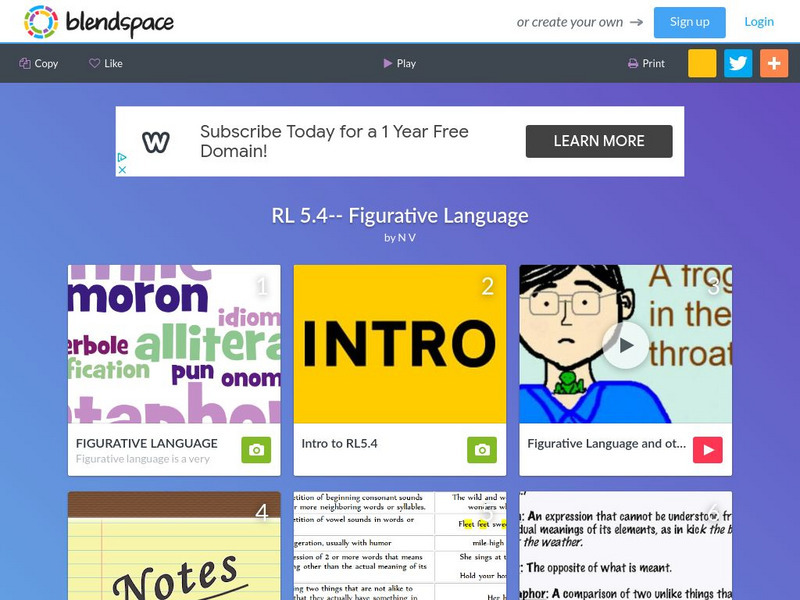

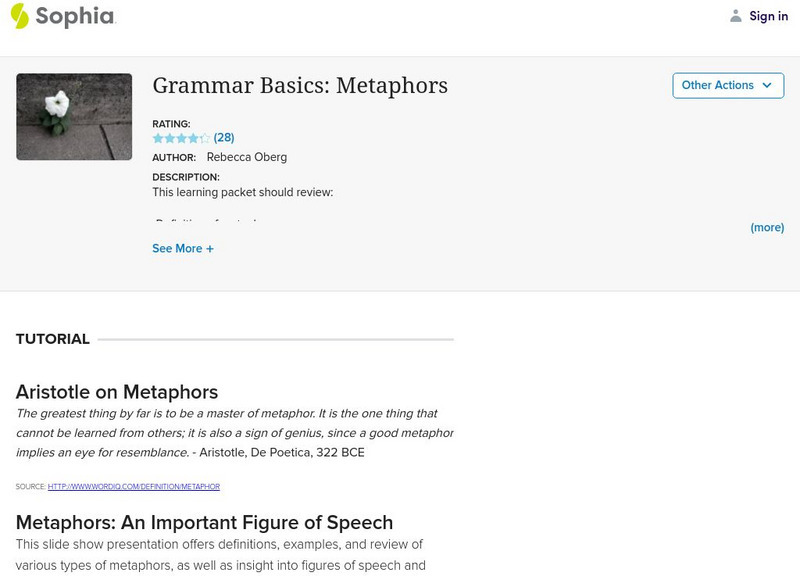
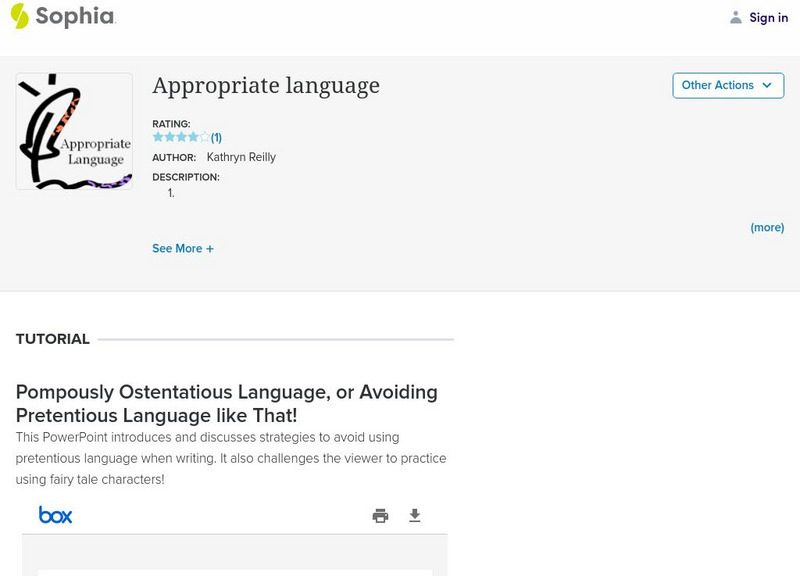
![Holt, Rinehart and Winston: Elements of Literature: Identifying Figures of Speech [Pdf] Graphic Holt, Rinehart and Winston: Elements of Literature: Identifying Figures of Speech [Pdf] Graphic](http://content.lessonplanet.com/resources/thumbnails/410154/large/bwluav9tywdpy2symdiwmduymc0yotywmi1ondh3nneuanbn.jpg?1589985628)



